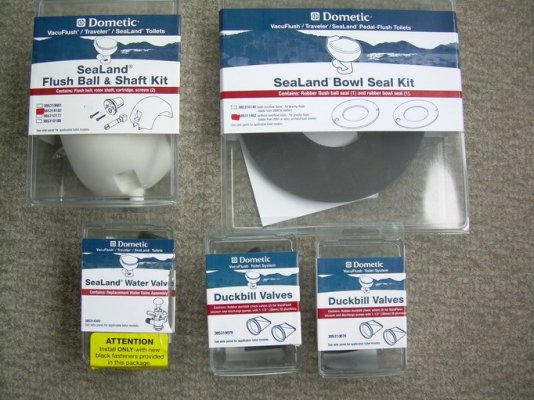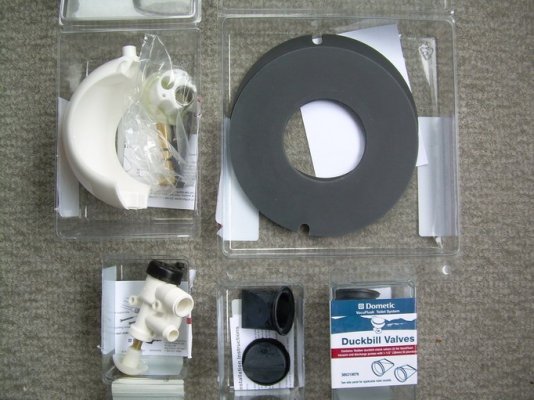The most important thing you need is an owners manual, 'cuz it lists just about every possible symptom, possible causes and cures that a Vacuflush can develop. If you don't have one, you can download it from here:
http://www.dometic.com/47dc839e-0c3a-476d-8b91-b83b27b06884.fodoc
It doesn't matter how old or new your system is...the VacuFlush hasn't changed enough to notice except cosmetically since it was first introduced in 19878 by the marine division of Mansfield Plumbing (which was spun off to a "startup" named SeaLand Technology in 1984)...so the manual for any year works for any other year.
There is no "service kit" for a VacuFlush...the only parts that you're likely need even if you leave the country for several years are duckbill valves (4), vacuum switch, water valve and vacuum breaker switch...and if it's a VERY old system, MAYBE a vacuum pump bellows. If you're just heading north up the ICW, you don't even need that much...just duckbills. If anything else goes wrong, the toilet will keep working...you can order parts from just about anywhere there's a marina or a boatyard.
A quick "VacuFlush 101" course may help you avoid problems:
It's a 3 component system--the bowl assembly, the vacuum accumulator tank (not to be confused with a holding tank) and a vacuum pump. The vacuum tank and vacuum pump may be a combined gizmo called the "vacuum generator," but it includes both and works the same way as separate vacuum tank and pump. The holding tank is NOT part of the VacuFlush toilet system...SeaLand just bundles holding tanks with the toilet system.
The vacuum pump has TWO functions: it suctions the air out of the plumbing between the toilet bowl and itself while simultaneously pushing the flush the rest of the way to the tank, treatment device or thru-hull. The vacuum tank has a switch and a sensor on it that starts the vacuum pump when there's a loss of "vacuum" (toilet is flushed or an air leak in the system) and turns it off when the correct amount of negative pressure has been reached. How long it runs depends on the distance from the pump to the bowl...the shorter the distance, the shorter pump run time. The accumulated "vacuum" only pulls the bowl contents TO the pump..the pump has to push it the rest of the way.
Air leaks are the only thing that will cause the vacuum pump to cycle between flushes for no reason. The most common source of air leaks is worn out duckbill valves in the vacuum pump 4 of 'em--2 in, 2 out...so if it does start cycling for no reason, first thing to do is replace 'em. They should be replaced about every two years as preventive maintenance...even annually if you live aboard.
As duckbills become more worn, the pump will cycle more often and will run longer and longer each time. A failing vacuum tank switch can also cause the pump to run longer--till eventually it won't turn off at all unless you turn it off at the breaker--but that will NOT cause the pump to cycle for no reason.
The two most common mistakes that V/Flush owners make are:
1) Easing the pedal back up instead of just letting it go.
It's spring loaded for a reason--to snap the dome back into place it with enough force to seat it and seal it. So just let it go! If you dont, over time youll develop an air leak in the bowl.
2. Using too little flush water.
SeaLand's claim that the V/Flush can use "as little as" 1 pint of flush water is VERY carefully worded. If only urine is flushed...no water added to the bowl first, no TP either...then yes, you CAN get away with that little, at least for a few flushes. But if you do much of that, unless you want odor, at least once a day you need to run at least half a bowl of clean water through it to rinse out the system. It's also advisable to add at least half a bowl of water ahead of solids or any TP (iow, every time a female uses the toilet)...that's a quart or more. It's also essential to leave the pedal down for at least 7-10 seconds after the bowl is empty to rinse out the pump and duckbills--to prevent a buildup in the pump or bits of waste or TP from becoming stuck in a duckbill, creating one of those pesky air leaks that causes the pump to cycle for no reason...at least another quart. And if you don't want permeated hoses, it's a very good idea--last thing before the boat will sit (or at least once a week if you're living aboard)--to fill the bowl to the rim with clean water and flush it through to thoroughly rinse out the vacuum tank, hoses and pump...'cuz suction splatters waste all over 'em and the flush water flow isn't sufficient to completely fill the hoses. So, averaged out over a week, the VacuFlush actually NEEDS about the same amount of flush water as most other toilets that use pressurized flush water: about .5 gal/flush. If you're using much less than that, you're asking for problems.
I'll be glad to answer any more questions.
Btw...are you aware that there's a K-K forum? Check it out here:
http://krogencruisers.net/dolphin/index.php

